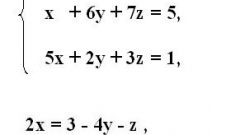Instruction
1
To simplify a polynomial, give similar terms. Example. Simplify the expression 12ax2–y3–6ax2+3a2x–5ax2+2y3. Find monomials with the same literal part. Fold them up. Note the resulting expression is: ax2+3a2x+y3. You have simplified a polynomial.
2
In problems that require the decomposition of a polynomial into factors, determine a common factor of the expression. To do this, first remove the brackets the variables that are part of all members of the expression. Moreover, these variables should have the lowest index. Then calculate the greatest common divisor of each of the coefficients of the polynomial. Module the resulting number will be the coefficient of the total multiplier.
3
Example. Decompose into factors of the polynomial 5m3–10m2n2+5m2. Remove the brackets m2, since the variable m is included in every member of this expression and its smallest index is two. Calculate the coefficient of the total multiplier. It is equal to five. Thus, a common factor of this expression is equal to 5m2. From: 5m3–10m2n2+5m2=5m2(m–2n2+1).
4
If the expression has no common factor, try to decompose it by grouping. To do this, combine into groups those members who have common multipliers. Take out a common factor of each group in brackets. Remove the brackets have a common factor of all the formed groups.
5
Example. Decompose into factors of the polynomial a3–3a2+4a–12. Make the group as follows: (a3–3a2)+(4a–12). Take out of the bracket common factor a2 in the first group and a common factor of 4 in the second group. Hence: a2(a–3)+4(a–3). Move the brackets the polynomial a–3, we get: (a–3)(a2+4). Therefore, a3–3a2+4a–12=(a–3)(a2+4).
6
Some polynomials are decomposed into factors using formulas of reduced multiplication. To do this, bring the polynomial to the desired form by way of grouping or making the brackets a General multiplier. Next, apply the appropriate formula of the reduced multiplication.
7
Example. Decompose into factors of the polynomial 4x2–m2+2mn–n2. Combine in brackets the last three members, while the brackets move to -1. Get: 4x2–(m2–2mn+n2). The expression in brackets can be represented as the squared difference. Hence: (2x)2–(m–n)2. This is the difference of squares, so we can write (2x–m+n)(2x+m+n). Thus, 4x2–m2+2mn–n2=(2x–m+n)(2x+m+n).
8
Some polynomials can be decomposed into factors by the method of undetermined coefficients. So, every polynomial of the third degree can be represented in the form (y–t)(my2+ny+k), where t, m, n, k – numerical coefficients. Consequently, the task is reduced to determining the values of these coefficients. This is done on the basis of this equality: (y–t)(my2+ny+k)=my3+(n–mt)y2+(k–nt)y–tk.
9
Example. Decompose into factors of the polynomial 2a3–a2–7a+2. From the second part of the formula for polynomial of the third degree make up the equation: m=2; n–mt=-1; k–nt=-7; –tk=2. Write them down in the form of a system of equations. Solve it. You will find the values for t=2; n=3; k=-1. Substitute the calculated coefficients in the first part of the formula, we get: 2a3–a2–7a+2=(a–2)(2a2+3a–1).






